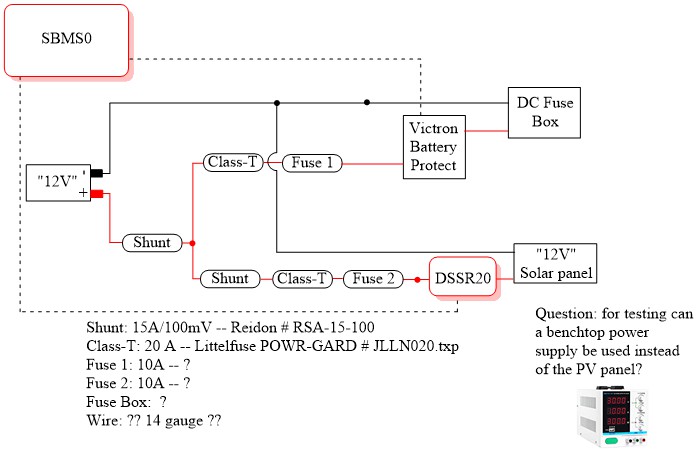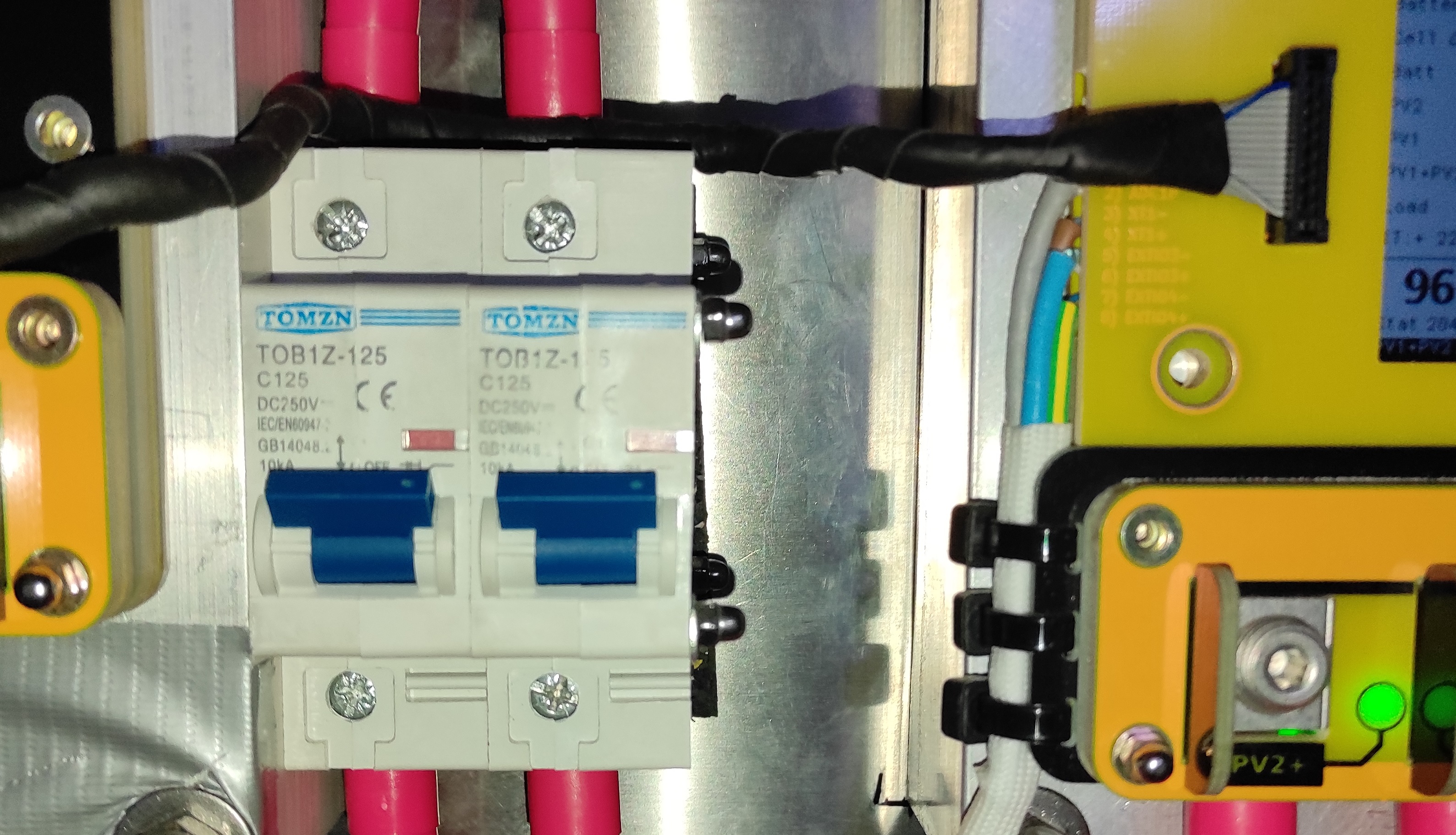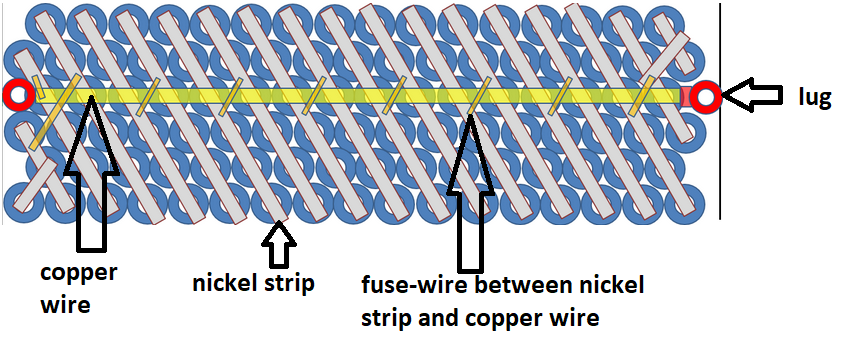Beginner Questions - Small Battery System, Design and Testing
已查看 236 次
跳至第一个未读帖子
Patrick Bazinet
2021年5月6日 14:52:142021/5/6
收件人 electrodacus
Hi all,

I am very new to the solar energy/storage field, but have decided to learn by doing. I am currently in building a system designed for 10A max charging and DC loads. I have purchased an SBMS0 and DSSR20 and two different kinds of batteries to experiment with (LiFePO4 - 26650 and LiCoO - 18650) and already have a basic 12V solar panel (10W I think). I still need to determine and purchase all the other components.
I would like to ask for some recommendations on the following:
1) Fuses - I am planning on a 20A Class-T fuse in case of catastrophe, but would like to add some 10A fuses which would be go first and be cheaper to replace if there was some overcurrent. Alternatively, this could be a circuit breaker. I am agnostic on the issue. Any recommendations?
2) DC Fuse Box - In the beginner's guide there is some language about automotive DC fuse blocks not being designed for LiFePO4 batteries. Does anyone have a recommendation for a very basic fuse block that would be appropriate?
3) Wire - Would 14 gauge stranded copper wire be ok for this setup? Any recs?
4) For testing purposes, do you think I can use a benchtop power supply instead of the solar panel? Can that output be run through the DSSR20, which can interrupt the current once the battery is charged? I'd only be running this at 1-2A for testing. If not, anyone have better idea for testing without relying on sun?
I'd like to thank everyone in advance for your time and advice.
Pat

Dacian Todea
2021年5月6日 15:10:112021/5/6
收件人 electrodacus
Pat,
1) I like this bidirectional circuit breakers https://www.amazon.ca/LANGIR-Single-Circuit-Breaker-Certificates/dp/B06WD7W416 you can get any rating from 6A up to 63A and are fairly inexpensive.
2) As long as you stay with 12V any automotive fuses should work.
3) If you will be using 20A fuses or breakers then you will need 12 AWG for the 10A protected circuits 14AWG will be just fine.
4) Yes you can use a lab type powers supply instead of a solar panels to connect through the DSSR20. And you can set any current you want up to 20A no problem for DSSR20
Patrick Bazinet
2021年5月6日 16:12:372021/5/6
收件人 electrodacus
Dacian,
Thank you very much for the quick response and the recommendation on the circuit breakers.
Just a quick follow question: Let's stipulate that I will use 10A circuit breakers and 14AWG wires. Is using a 20A Class-T fuse OK? Or do I need 12AWG wires from the battery to the Class-T fuses?
Thanks again,
Pat
Dacian Todea
2021年5月6日 16:22:302021/5/6
收件人 electrodacus
Pat,
It depends on what sort of wires do you have meaning what insulation temperature rating they have and how long are those wires and if they are in open air of inside a conduit maybe with other wires.
Normally 14AWG wire with at least 75C rated insulation should be good for up to 20A the 12AWG with same insulation will be good for 25A and both breakers and fuses are not that precises it may require 30A for quite some time for a 20A fuse to blow depending on ambient temperature and the luck with the fuse you get (there could be more than 20 to 30% difference between fuses of same rating and brand).
If you are thinking about 14 AWG silicone insulated wire with 150 or 200C silicone insulation then you will have no problem with 20A
Jhon
2021年5月7日 17:47:062021/5/7
收件人 electrodacus
Hello Pat, I tend to go slightly bigger for the wires than I need to by code as I don't like them to feel warm to the touch and when the heat can't dissipate it can create problems. Besides heat is waste and sometimes even needs a fan (more waste) to cool the items. I would also make the shunt at least twice the size as the max current, again because heat is waste. (By slightly bigger I mean I go up to something like 80% of the max rated current, depending on the situation) I also like circuit breakers much better, but they are bulky and in a small boat, that could be a consideration.
Peter
2021年5月9日 11:44:452021/5/9
收件人 electrodacus
Dacian (and others), would you believe these chinese circuit breakers?
Dne čtvrtek 6. května 2021 v 21:10:11 UTC+2 uživatel electr...@gmail.com napsal:
Dacian Todea
2021年5月9日 12:55:012021/5/9
收件人 electrodacus
Peter,
This are a bit more expensive than those on aliexpress but I have this and they are good quality https://www.amazon.com/Miniature-Circuit-Breaker-Protection-Installation/dp/B06XDTB1Y6
Plamen
2021年5月9日 13:19:212021/5/9
收件人 electrodacus
Actually i use that brand.  16A for each PV i have and two 125A for each PV input of the SBMS120. So far none tripped and no magic smoke.
16A for each PV i have and two 125A for each PV input of the SBMS120. So far none tripped and no magic smoke.
 16A for each PV i have and two 125A for each PV input of the SBMS120. So far none tripped and no magic smoke.
16A for each PV i have and two 125A for each PV input of the SBMS120. So far none tripped and no magic smoke.
Dacian Todea
2021年5月9日 13:40:112021/5/9
收件人 electrodacus
Palmen,
Those are quite a few breakers :) It will have been half if you used 32A version with groups of two parallel panels for each. You can measure voltage drop on them when current is the same through all maybe at noon in a sunny day then you can know if they are all equal or there are large tolerances in contact resistance between them. But is likely just around 10A trough 16A breakers so even if not that great they will still handle that and they are mostly used as disconnect switches in this case.
The advantage of those that I showed is that they are bidirectional meaning can stop the current flow in both directions.
Plamen
2021年5月9日 14:10:012021/5/9
收件人 electrodacus
Hi Dacian,
I will do that, those are a mix of PV i added through the years 3+3+6+2 so four different brands but at least will know the tolerance for each one.
Now the bidirectional part. I thought that means one can connect them without observing polarity and that's all. The bimetallic/heat (slow action) part of the breaker will work equal regardless of current flow direction. What You say is that on a breaker with polarity the coil (fast) part will not trip if current flow is reversed?
Plamen
2021年5月9日 15:26:552021/5/9
收件人 electrodacus
I've got it. It's not the coil but the the mechanism to interrupt/extinguish the arc.
Peter
2021年5月9日 20:28:242021/5/9
收件人 electrodacus
Wow.. yes,
quite a few breakers. Tomzn breakers..
I appreciate Dacians recommendation of
Langir breakers. But "a bit more expensive" is $2 vs $10.
Plamen, did/could you try to measure contact resistance and test tripping current? Thank you.
Dne neděle 9. května 2021 v 21:26:55 UTC+2 uživatel Plamen napsal:
Patrick Bazinet
2021年5月10日 09:15:012021/5/10
收件人 electrodacus
Thank you all for your inputs. I will be getting Langir circuit breakers (I don't need many).
If I may, I'd like to pose another question:
Let's say that I am building a 4s8p LiFePO4 battery pack out of small cylindrical cells (18650 or 26650). Max planned charging or discharging current is 10A. Should each individual cell have a fuse? If so, what would be the current rating of the fuses (10A / 8 cells = 1.25 A/cell)? Based on what I've read in the group discussions, I would think the answer is no. But, I've seen some Youtube videos (I don't take these to be authoritative) show building 18650 battery packs with "fuse wires". Small wires that will act as fuses and melt should the current get too high.
Peter
2021年5月10日 10:55:052021/5/10
收件人 electrodacus
LiFePo4 cell fuses:
(only my opinion) I would consider LiFePo4 as very safe lithium chemistry. You are building relatively small pack and if cells are new and all from the same factory batch, I would not do these wire fuses. I agree with your calculation 10/8 = 1.25 A/cell. Fuse could be 1.5A.
Reason for these fuses is that if one cell turns dead, others will send their energy into this zombie. If there are many cells in the same block with high amp rating, this current flow could be problematic and thats the point where fuse wire on the zombie cell should save the day. But you have only few cells in parallel and LiFePo4 does not give biggest amps. Thats why in your case in such small pack and with LiFePo4 I would not do these fuses.
I guess you will monitor the pack and if voltage of some block gets lower, there is quite standard procedure, how to deal with the problem: 1) optically inspect the block for defects; 2) while charging problematic block defective cell should have higher temprerature.
I am also building LiFePo4 pack, but mine is 8s100p. I am going to put these wire fuses on every 6 cells. So I wont have to solder wires to cells:

In case someone is interested in that little
discussion about DC circuit breakers, those Tomzns, that Plamen uses,
are all C curve. I am wondering if B curve would be more appropriate for
PVs?
Dne pondělí 10. května 2021 v 15:15:01 UTC+2 uživatel patba...@gmail.com napsal:
Plamen
2021年5月10日 14:08:092021/5/10
收件人 electrodacus
Peter, i'll do that but saturday or sunday if the weather is sunny. When i get home sun is already too low to do that during the week.
Dacian Todea
2021年5月10日 16:33:302021/5/10
收件人 electrodacus
You will just complicate things if building a battery from that many small parallel cells. Not sure what you need the battery for but you should just look at larger cells and have just 4 of those in series.
If you reasoning is that cylindrical cells do not need compression then you can look at the larger Headway cells they have 8,10,15,17Ah cells. Then you can do a 4s or a 4s2p out of those and you do not need any fusing and connecting them is done simply with screws (bolts).
Plamen
2021年5月16日 13:21:102021/5/16
收件人 electrodacus
Today was sunny, no clouds +35 celsius. Disconnected all breakers and started measuring the voltage drop one by one. From 14 most are at 0.05 volts and had two at 0.04. Not sure how to interpret those results and if it's fine or great. At 103 amps when all connected it's about 7.4 amps per breaker or 0.370 watt as heat.
Friday i had the main fuse blown. It was a 250A. With maybe 10 amps of DC loads and inverter rated at 3000 watts (6000 for a few seconds). It has overload protection and inside is fitted with a 300A fuse (factory). I had a clothes dryer on 2300w max. forgotten about it and turn on an electric grill 1800w too. Guess booth were cycling on/off for a few minutes and not triggered the overload protection buy the fuse gave up.
On Sunday, May 9, 2021 at 7:40:11 PM UTC+2 electr...@gmail.com wrote:
Dacian Todea
2021年5月16日 14:13:102021/5/16
收件人 electrodacus
Plamen,
Thanks for testing. You can compare with some of my breakers but they are all higher rating https://groups.google.com/g/electrodacus/c/CflxSzTsKaY/m/N4CVd6G_AQAJ
So is the 0.05V at 7.4A ? As that will be about 7mOhm and that will be OK for those 16A rated breakers. The closest I have is the 63A rated Langir that is at around 2mOhm
Maybe you can measure the voltage drop on the larger 125A breakers you have from same brand.
Fuses are quite variable and with your high ambient temperature is not that unlikely to fail maybe even at 150A if there was some extra heat from bad connection on one of the fuse contacts. It also depends on the quality of the fuse but even with quality ones there is a huge variation.
Fuses are quite variable and with your high ambient temperature is not that unlikely to fail maybe even at 150A if there was some extra heat from bad connection on one of the fuse contacts. It also depends on the quality of the fuse but even with quality ones there is a huge variation.
Plamen
2021年5月16日 14:54:422021/5/16
收件人 electrodacus
Hi Dacian,
When all 14 connected it was 103A, i did not note for each one. And PV vary from 250w to 280w. Will measure each of the 125A but likely next weekend. Actually those two are bidirectional.
I'll double that fuse, cables there are 1AWG.
Peter
2021年5月16日 18:03:472021/5/16
收件人 electrodacus
Hello Plamen, Dacian and others,
thank you a lot for testing results of breakers.
In the end I have discovered "better local Langirs".
Local company OEZ is offering here in Czech republic breakers at lower price level than those Langirs.
For example here:
- bidirectional 63A: https://www.oez.com/lts-63b-1
- unidirectional 125A: https://www.oez.com/lvn-125c-1
According to datasheet 63 rated breaker should have 1.5mOhm and 125 rated breaker even 0.7mOhm!!!
That is imho way better than chinese Tomsns. My solution is in the van so every watt maters to me as I am not able to add more PVs.
Even though I am not sure, how these OEZ breakers are internationally available, I will share some real life measurements.
The point can be that searching for local vendors of this kind of stuff maybe also the way.
I will also buy some T-class equivalent fuses from OEZ for very pleasant price.
Can I discuss here breakers vs fuses subject?
As I understand it now, breakers are better than fuses in terms of:
- speed in breaking short circuit thanks to the coil, even 5x continuous current rating which is way better than T class fuses,
- switching ability.
Disadvantages of breakers in comparison with fuses are:
- only up to 125A,
- slightly higher internal resistance than fuses, seems it highly depends on quality of the breaker,
- smaller breaking capacity - typically 10kA in comparison with 50kA+ of T class fuses, but it is still acceptable for our LiFePo4 batteries,
- i would like to write price but some fast acting fuses are pretty damn expensive.
Would you guys agree with simplification mentioned above?
Considering breaking capacity 10kA of breakers..
Would anyone know what the approximate short-circuit current of LiFePo4 is? I was not able to find it online and I am not able to test it myself.
For example what could be short circuit current of 100A LiFePo4 cell?
Can I put 10kA breaker next to my 600A LiFePo4 pack?
Thank you.
Dne neděle 16. května 2021 v 20:54:42 UTC+2 uživatel Plamen napsal:
Dacian Todea
2021年5月17日 01:59:472021/5/17
收件人 electrodacus
Peter,
There are circuit breakers with larger capacity than 125A just not in that format.
Also those larger breakers have higher breaking capacity.
Large rating fuses are simpler and less expensive than large breakers.
short circuit current depends on the resistance of the short circuit that includes the wires and connections in that short circuit and the internal resistance of the cells
So say a 0.5mOhm 3.2V LIFePO4 cell shorted on the terminals will provide 6400A but there are cells with much lower internal resistance so one with 0.1mOhm or maybe multiple cells in parallel that will result in that equivalent 0.1mOhm will result in to a 32kA of short circuit current if there is no additional resistance maybe contact resistance and cables so even if you add that 1.5mOhm for the 63A breaker short circuit will be reduced.
Plamen
2021年7月3日 06:29:272021/7/3
收件人 electrodacus
The 125A breakers i have are at 0.10~0.12V at 50~52A.
Changed the fuse to 500A and at 90A load it's already too hot. Probably will try with 1000A.
On Sunday, May 16, 2021 at 8:13:10 PM UTC+2 electr...@gmail.com wrote:
回复全部
回复作者
转发
0 个新帖子
